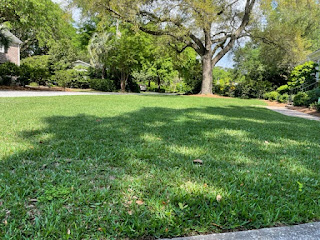Mosquito - #1 killer of humans world-wide
Horticulture Hotline 04/24/23
By Bill Lamson-Scribner
Here is a quick list of questions about events in the yard:
Soil tested? Custom Program written? Apply the products that your soil needs instead of guessing. Doing soil tests are cheaper and provide better results than random applications. Why do you think farmers with hundreds of acres’ soil test?
“I started using Possum’s recipe for my lawn 3 years ago and I have never had a better lawn in the 35 years that I have been trying to grow the perfect lawn. Possum’s is awesome! I have the best lawn in the neighborhood.” Greg Lienert
“Great products for my lawn. 15-00-15 Lawn Food! My lawn never looked better! Better than Scotts! Great Products!” George Bryant
Mosquitoes? Do you have a plan? Have anything collecting water outside – gutters, flower pot dishes, bird bath, tarps, water bowl, children’s toys…?
Prune and fertilize azaleas, camellias, and other spring flowering plants after they bloom? Wait on Gardenias for now.
Fertilized your trees and shrubs? 17-00-09, 08-02-04 (organic)? Professional feeding?
Huge fleshy leaves on new growth of camellias and azaleas? Leaf gall? Remove infected leaves and destroy.
Is Powdery mildew attacking roses, crepe myrtles, dogwoods? Neem PY (organic) Perfect weather conditions – dry and cool nights.
Large Patch Fungus in turf – get an early start – prevention is cheaper than curative. Strobe Pro, T-Methyl, and Heritage are a few good chemical controls. Crab Shell by Neptune Harvest, SeaHume, and Cotton Burr Compost are organic products that we are told lessen the situation. Managing your water and drainage will also help – wetting agents?
Adult mole crickets are tunneling and mating – babies to come soon - manage them. Intice Bait.
Fire ants are starting to forage – manage them. Wisdom, Bug Blaster, and Extinguish Plus.
Grubs are near the surface – manage them. Some of these grubs will emerge into Japanese beetles that will shred your plant’s foliage in a month (especially roses and crepe myrtles). Kill them now! Lebanon Insect Control, Above and Below, and Grub X.
Get a “jump” on fleas this year. Lebanon Insect Control, Bug Blaster outside. Precor 2000, Alpine Flea Insecticide with IGR, or D-Fence NXT all have an adulticide as well as a growth regulator and are labeled for indoor use. Petcor to apply to pet.
Plant a vegetable garden?
Plant a flower garden?
If you applied preemergent in February, it is time for your second application (depending on the rate and product you used the first time). Remember the ornamental beds!
The leaves have fallen – new mulch? Try Cotton Burr Compost as a mulch and give that sweet compost tea to your plants and trees every time water runs through the compost.
Fertilized Palm Trees with 07-00-09 (the most awesome Palm Fertilizer)?
Tested your well water? Many are getting salty.
Pruned holly fern, cast iron plant, and monkey grass (Liriope)?
Moles? Mole Patrol or Traps, Sevin then Repellex? Moles are having babies (multiplying) this month!
Checked your irrigation?
Always read, understand, and follow product label – it is a Federal Law.









